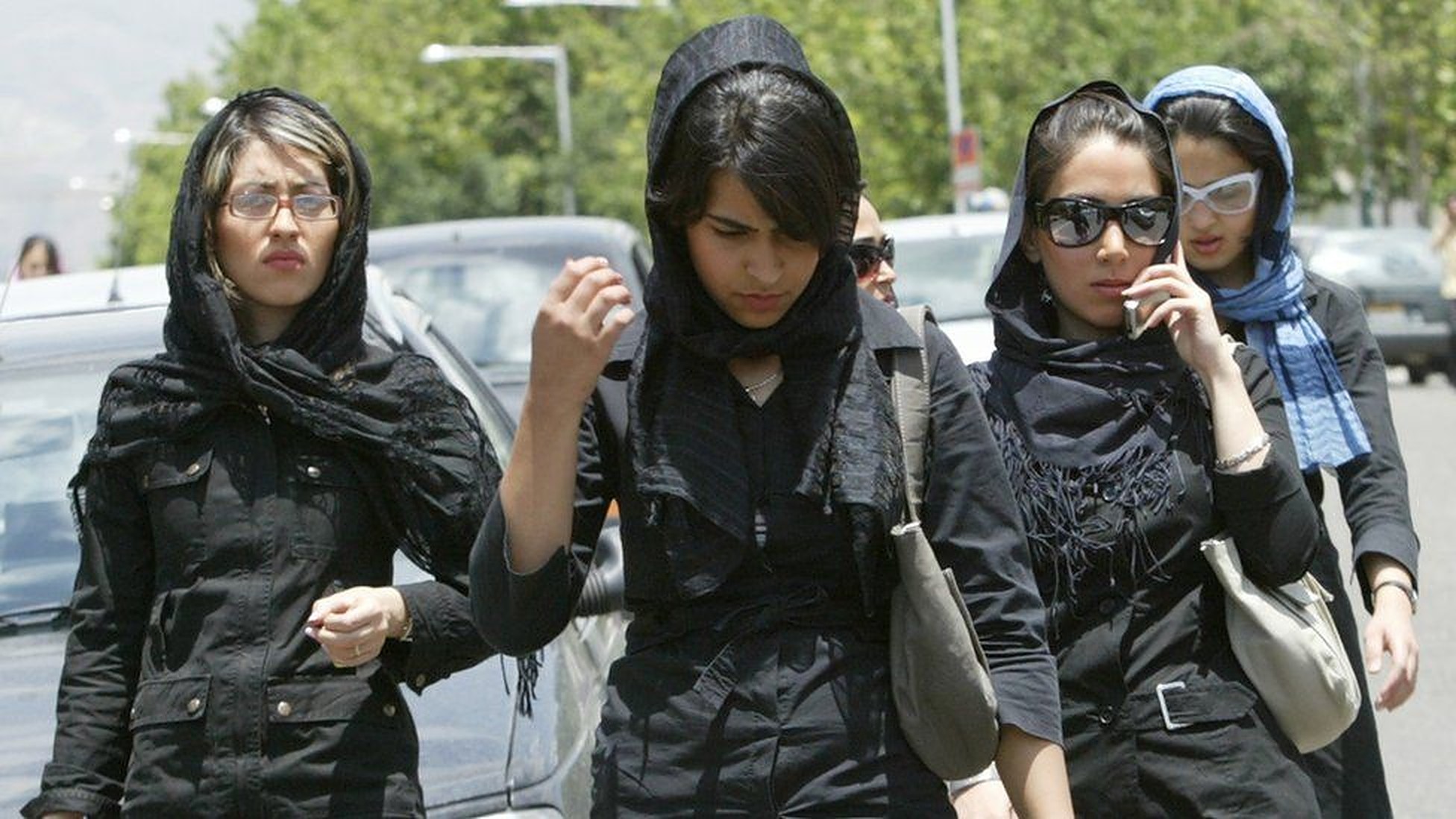A badly placed veil. A bright, deep red gloss. A tight fabric. A fairly thin headscarf exposing strands of a woman’s hair. These are only a few examples of how a woman can be charged with ‘immoral dress’ by the morality police of the Islamic Republic of Iran.
Just yesterday, Iran’s President Ebrahim Raisi vowed to reactivate the morality police and enforce mandatory hijab law. This comes just one month before the one-year anniversary of Mahsa Amini‘s death, following her arrest for allegedly not properly wearing the headscarf. Parliamentarians in the country were reportedly surprised that the reactivation took place without approval by the parliament.
“The morality patrol was shut down due to criticism of police behavior … Before redeploying the force, we must first do a cost-benefit analysis of its work,” parliamentarian Mahmoud Abbaszadeh Meshkini expressed to the media.
Layers of repression

After months of protest last year, women in Iran are now seeing their voices, their courage, and their fight for freedom erased and forgotten.
While acts of hijab burning and hair cutting dominated global headlines and social media, their protests were reduced to retweets, comments, and likes, with no real support from outside actors to drive reforms and positive change.
Controlling protests is a tactic that has long been deployed by the government. In 1979, shortly after Ayatollah Khomeini’s speech on mandatory hijab was aired in the media, Iranian women protested the infringement of their right to freedom by taking to the streets.
Yet the loud cries of women and girls were merely seen as an opportunity for the government to further repress women and manipulate the public into accepting their rules by tying their dress code to access to basic socio economic rights, such as employment and education.
For instance, businesses and companies were obliged by law to not hire women who do not adhere to the dress code. In 2022, Raisi also signed a decree that prevents women who post images of themselves online without a headscarf from receiving any social benefits for a period of six months to a year.
In April of this year, the Iranian health and education ministries also barred women from health and educational services if they fail to comply with the dress code.
Over the years, the government has proven skillfully adept at “managing” protests or any signs of social discontent, so much so that the public would have to untangle the many complex layers of repression, starting from the judiciary, the media, and the larger security operation to achieve freedom.
Living in a place where all state agencies are directly or indirectly involved in suppressing dissent, protest eventually takes on new and unconventional forms – such as the rise of protest fashion in Iran.
Protest fashion
Since 1979, Iranian women have been using various visual and fashion tactics to protest the mandatory hijab law.
Up until the early 2000s, activism in the public sphere was largely limited. With the advent of digital technologies, private spaces have become more helpful for women to communicate with one another outside of formal state channels, and it has also eroded the distinction between the public and private.
The digital sphere can also be seen or described as a shadow state, where women can escape the many layers of repression that exist in the public realm, and cultivate a safe space for them to defy the state’s laws.
Popular social media platforms like Instagram are frequently utilized by influencers, women-owned businesses, and lifestyle bloggers to protest. Virtual Private Networks (VPNs) are also used by millions of Iranians to get around internet censorship.
Below are some examples of how fashion was used over the years as a form of protest.
White Wednesdays
In 2017, using the hashtag #whitewednesdays, Iranian women started posting images and videos of themselves wearing white attire or headscarves as signs of protest.
Activist Masih Alinejad, the brain behind the online movement My Stealthy Freedom, was the main creator behind the tactic. The early reception of the campaign was momentous, as more than 200 videos were sent to Ms Alinejad in the first two weeks, some of which received 500,000 views in the first two weeks.
The campaign twists the practice of wearing pink on Wednesdays , which was popularized worldwide following the release of the film Mean Girls in 2004, to instead wearing white, which Alinejad hopes can become a wider global movement that defends Iranian women’s rights.
“#WhiteWednesdays is more than just a campaign led by women who are fighting against [a] small piece of cloth…we are fighting against the philosophy behind it, the men behind these compulsory hijab laws telling us what to wear, how to behave, and what kind of lifestyle to follow,” said Alinejad in a 2018 interview with NPR.
The Millimeter Revolution
In the late 1980s, women in Iran launched what is now called “millimeter revolution” — sliding their headscarves back one millimeter. The more the headscarf slides backwards, the more it symbolizes a woman’s courage to resist the law.
The movement also became a symbol of how, although Iranians’ resistance may be seen as slow and gradual, it will eventually erupt.
Over the years, women in Iran have documented the progress of their movement online by wearing their headscarves as a regular scarf on their shoulders, with visible photographs of Iranian women walking down the streets with scarves hanging around their shoulders.
Red Nail Polish
Thousands of women banded together in the summer of 2004 to show up in Tehran’s streets wearing open-toed shoes and red nail polish on their hands and toes.
The rationale behind the movement was that the punishment, which involved covering a woman’s feet with insects and hands with cockroaches, could not possibly be meted out to thousands of women at once.
The movement was so influential that it forced the government to accept pen-toed shoes after July 2004.
Men in Scarves, Women in Beards
Women were not the only ones that used fashion to protest, but men as well.
In 2009, Iranian men posted images of themselves online wearing women’s headscarves as a political statement. Since then, to protest the country’s harsh hijab law, several men online have begun dressing in headscarves while standing close to their spouses or female relatives who are not wearing a headscarf.
Women also used disguise as a form of protest. For instance, in violation of a restriction on women attending football matches, a group of women football enthusiasts disguised themselves with wigs and false beards to attend a significant football match in Iran in 2018. Pictures and videos of them gained popularity on social media upon their release.
To explore more deeply how Iranian women have used their visual appearance as a tool of resistance, a brand new book of pictures, Breathing Space (2023), displays the creative ways local Iranian artists and photographers have overcome limitations to express themselves.
The cover of the book shows a woman wearing a black coat, a black headscarf and black boots in compliance with Iran’s Islamic dress code. But there is another accessory that exposes her rebellious spirit beneath: her red boxing gloves.






Comments (3)
[…] Fashion Jihad: How Iranian Women Used Fashion to Protest 7 Mediterranean Species Threatened Due to Rising Temperatures […]
[…] post Fashion Jihad: How Iranian Women Used Fashion to Protest first appeared on Egyptian […]